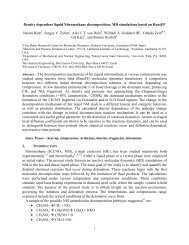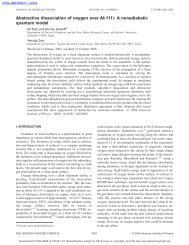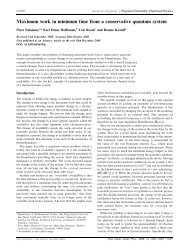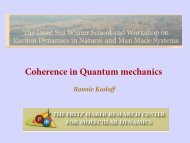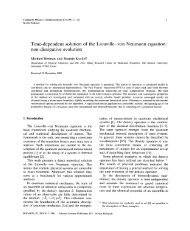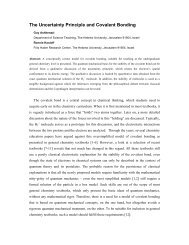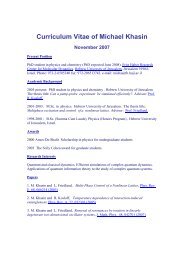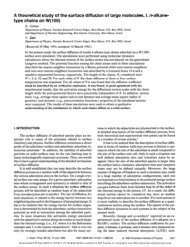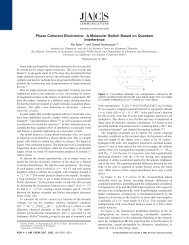Solvatochromic Shifts of “Super” - The Fritz Haber Center for ...
Solvatochromic Shifts of “Super” - The Fritz Haber Center for ...
Solvatochromic Shifts of “Super” - The Fritz Haber Center for ...
You also want an ePaper? Increase the reach of your titles
YUMPU automatically turns print PDFs into web optimized ePapers that Google loves.
<strong>Solvatochromic</strong> <strong>Shifts</strong> <strong>of</strong> <strong>“Super”</strong> Photoacids<br />
Kyril M. Solntsev † and Dan Huppert<br />
School <strong>of</strong> Chemistry, Raymond and BeVerly Sackler<br />
Faculty <strong>of</strong> Exact Sciences<br />
Tel-AViV UniVersity, Tel AViV 69978, Israel<br />
Laren M. Tolbert<br />
School <strong>of</strong> Chemistry and Biochemistry<br />
Georgia Institute <strong>of</strong> Technology<br />
Atlanta, Georgia 30332-0400<br />
Noam Agmon*<br />
<strong>The</strong> <strong>Fritz</strong> <strong>Haber</strong> Research <strong>Center</strong><br />
Department <strong>of</strong> Physical Chemistry<br />
<strong>The</strong> Hebrew UniVersity, Jerusalem 91904, Israel<br />
ReceiVed March 16, 1998<br />
Hydroxyarenes (ROH molecules) undergo significant enhancement<br />
in their acidity upon electronic excitation. 1,2 For example,<br />
the acidity <strong>of</strong> 2-naphthol (2N) in water increases from pKa ) 9.5<br />
in the ground state (S0) topKa* ) 2.8 in its first excited singlet<br />
state (S1). 1 It is sufficiently acidic to transfer a proton to water<br />
during its radiative lifetime, but not to pure organic solvents.<br />
Recently, enhanced photoacids based on cyano derivatives <strong>of</strong> 2N<br />
have been synthesized and characterized. 3,4 For example, 5-cyano-2-naphthol<br />
(5CN2OH) has pKa* ≈ -1. 5 <strong>The</strong> nearly 4 pKa<br />
unit difference from 2N is sufficient to allow proton transfer to<br />
an array <strong>of</strong> organic solvents, leading to the appearance <strong>of</strong> a low<br />
energy RO - band in the fluorescence spectrum. We consider<br />
here the ROH band, which shows large solvent-induced (“solvatochromic”)<br />
spectral shifts. For example, between hexane and<br />
dimethyl sulfoxide (DMSO), it red shifts by about 3000 cm -1<br />
<strong>for</strong> 5CN2OH, as compared with 1200 cm -1 <strong>for</strong> 2N. We focus<br />
on the origin <strong>of</strong> this large shift and its possible connection to the<br />
enhanced photoacidity.<br />
Solvent-induced spectral shifts are usually attributed to solvent<br />
(S) polarity/polarizability effects and its hydrogen-bond (HB)<br />
donating or accepting properties. <strong>The</strong>se are quantified by the<br />
empirical solvatochromic parameters <strong>of</strong> Taft and co-workers: 6,7<br />
π*, R, and . In contrast, acid strength is determined by solvent<br />
basicity (its proton accepting tendency) and its dielectric properties.<br />
8 <strong>The</strong> excited R*OH is expected to have a larger dipole<br />
moment and stronger R*OH‚‚‚S bond than in the ground state.<br />
To disentangle the relative effects <strong>of</strong> and π* on the R*OH shifts,<br />
we compare the behavior <strong>of</strong> 5CN2OH with its methoxy analogue,<br />
5-cyano-2-methoxynaphthalene (5CN2OMe), which is incapable<br />
<strong>of</strong> donating a HB to the solvent. Hydrogen bonding, such as in<br />
aminoarenes (HB acceptors), is known to induce mild deviations<br />
from the π* correlation. 9,10 We demonstrate that in 5CN2OH<br />
the HB-induced bathochromic shift is substantial. Thus, specific<br />
solvation, due to hydrogen bonding, is as important as nonspecific<br />
polar solvation.<br />
Synthesis and purification <strong>of</strong> 5CN2OH and its 5CN2OMe<br />
precursor is described elsewhere. 3,4 Solvents (Table 1) were<br />
analytical grade and did not contain fluorescent impurities.<br />
† Also at the Hebrew University <strong>of</strong> Jerusalem.<br />
(1) Weller, A. Prog. React. Kinet. 1961, 1, 187.<br />
(2) Förster, T. Pure Appl. Chem. 1970, 24, 443.<br />
(3) Tolbert, L. M.; Haubrich, J. E. J. Am. Chem. Soc. 1990, 112, 8163.<br />
(4) Tolbert, L. M.; Haubrich, J. E. J. Am. Chem. Soc. 1994, 116, 10593.<br />
(5) Huppert, D.; Tolbert, L. M.; Linares-Samaniego, S. J. Phys. Chem. A<br />
1997, 101, 4602.<br />
(6) Kamlet, M. J.; Abboud, J.-L. M.; Abraham, M. H.; Taft, R. W. J. Org.<br />
Chem. 1983, 48, 2877.<br />
(7) Laurence, C.; Nicolet, P.; Dalati, M. T.; Abboud, J.-L. M.; Notario, R.<br />
J. Phys. Chem. 1994, 98, 5807.<br />
(8) Lagowski, J. J. Crit. ReV. Anal. Chem. 1971, 2, 149.<br />
(9) Rosenberg, H. M.; Eimutis, E. Spectrochim. Acta 1966, 22, 1751.<br />
(10) Chapman, C. F.; Fee, R. S.; Maroncelli, M. J. Phys. Chem. 1995, 99,<br />
4811.<br />
J. Am. Chem. Soc. 1998, 120, 7981-7982<br />
Table 1. Peak Emission Frequencies <strong>of</strong> the Two<br />
Cyanonaphthalene Derivatives in Different Solvents<br />
solventa π* b c νp d νp e<br />
hexane -0.11 0 28.28 28.22<br />
c-hexane 0 0 28.18 28.17<br />
CCl4 0.21 0 27.9 27.84<br />
Et2O 0.24 0.47 27.2 27.72<br />
EtOAc 0.45 0.45 26.81 27.5<br />
EtOH 0.54 0.77 25.89 27.3<br />
MeOH 0.60 0.62 25.93 27.12<br />
ACN 0.66 0.31 26.76 27.14<br />
CH2Cl2 0.73 0 27.33 27.46<br />
C2H4Cl2 0.73 0 26.98 27.43<br />
TFE 0.73 0 26.00 26.82<br />
DMFA 0.88 0.69 25.38 26.86<br />
DMSO 1 0.76 25.11 26.55<br />
“water” 1.09 0.4 f 25.65 g 26.45 g<br />
7981<br />
a Acronyms: diethyl ether (Et2O), ethyl acetate (EtOAc), ethanol<br />
(EtOH), methanol (MeOH), acetonitrile (ACN), trifluoroethanol (TFE),<br />
dimethyl<strong>for</strong>mamide (DMFA), dimethyl sulfoxide (DMSO). b From ref<br />
7. c From ref 6. d Frequency <strong>of</strong> peak 5CN2OH emission, in 1000 cm -1 ,<br />
as obtained from a fit to the log-normal distribution. 13 e Same <strong>for</strong> the<br />
5CN2OMe compound. f From ref 21. g Estimated from water/MeOH<br />
or water/ACN mixtures.<br />
Fluorescence spectra were recorded on a SLM-AMINCO-Bowman<br />
2 luminescence spectrometer and corrected according to<br />
manufacturer specifications. All measurements were per<strong>for</strong>med<br />
at room temperature (ca. 22 °C). Sample concentrations were<br />
adjusted to optical densities <strong>of</strong> 0.05-0.1 at the excitation<br />
wavelength. Excitation spectra were independent <strong>of</strong> the emission<br />
wavelength and roughly the same as the absorption spectra in<br />
the S0 f S1 spectral region. Likewise, emission spectra were<br />
independent <strong>of</strong> the excitation wavelength.<br />
<strong>The</strong> red-edge maximum in the 5CN2OMe excitation (or<br />
absorption) spectrum exhibits a very weak bathochromic shift,<br />
from 29 300 cm -1 in hexane to 29 150 cm -1 in DMSO (not<br />
shown). This could indicate a very small ground-state dipole<br />
moment. 11 5CN2OH exhibits a larger shift, from 29 400 cm -1<br />
in hexane to 28 700 cm -1 in DMSO. This excess shift seems<br />
uncorrelated by the π* polarity scale; in nonprotic solvents it<br />
increases in the order <strong>of</strong> solvent HB accepting ability, . We<br />
conclude that a weak HB preexists in the ground electronic state, 12<br />
contributing to 5CN2OH solvation.<br />
A more quantitative analysis is possible from the emission<br />
spectra, Figure 1, which are sensitive to the excited-state<br />
properties. <strong>The</strong>se spectra, which show sizable solvatochromic<br />
shifts, are fitted by the log-normal distribution, 13 which serves to<br />
average over the vibrational structure. From these fits (not<br />
shown), the peak frequency, νp, has been extracted using previously<br />
described procedures 14 (see Table 1). <strong>The</strong> shifts <strong>for</strong><br />
5CN2OMe emission are shown by the circles in Figure 2a. With<br />
the exclusion <strong>of</strong> the haloaliphatic compounds, they obey the<br />
correlation<br />
ν p (5CN2OMe) ) 28 120 - 1520π* (cm -1 ) (1)<br />
extremely well (correlation coefficient r ) 0.996). Thus,<br />
5CN2OMe solvatochromism is adequately explained by polarity/<br />
polarizability effects.<br />
In contrast, the 5CN2OH shifts (+ symbols) do not correlate<br />
well with π*. Assuming that the dipole moments <strong>of</strong> 5CN2OMe<br />
and 5CN2OH are similar, 5CN2OMe is a good reference<br />
compound <strong>for</strong> polarity effects on 5CN2OH. Thus the excess shift,<br />
(11) Mataga, N.; Kubota, T. Molecular Interactions and Electronic Spectra;<br />
Marcel Dekker: New York, 1970.<br />
(12) Baba, H.; Suzuki, S. J. Chem. Phys. 1961, 35, 1118.<br />
(13) Siano, D. B.; Metzler, D. E. J. Chem. Phys. 1969, 51, 1856.<br />
(14) Agmon, N. J. Phys. Chem. 1990, 94, 2959.<br />
S0002-7863(98)00860-9 CCC: $15.00 © 1998 American Chemical Society<br />
Published on Web 07/24/1998
7982 J. Am. Chem. Soc., Vol. 120, No. 31, 1998 Communications to the Editor<br />
Figure 1. A comparison <strong>of</strong> 5CN2OH fluorescence emission spectra (in<br />
arbitrary intensity units) in different solvents (full lines) with those <strong>of</strong><br />
the methoxy analogue (dashed lines).<br />
Figure 2. (a) <strong>The</strong> shift <strong>of</strong> peak R*OH emission frequency <strong>for</strong> the two<br />
cyano dyes, as obtained from a log-normal fit to the spectra in Figure 1.<br />
(b) <strong>The</strong> difference in the peak emission frequencies <strong>of</strong> the two cyano<br />
dyes correlate with but not with π*.<br />
∆νp ≡ νp(5CN2OMe) - νp(5CN2OH), reflects nonpolarity effects.<br />
Figure 2b shows that, with the exclusion <strong>of</strong> the haloaliphatics<br />
(squares), the emission data obeys<br />
∆ν p )-100 + 1980 (cm -1 ) (2)<br />
with r ) 0.973. Hence, ∆νp measures the enhancement <strong>of</strong> the<br />
5CN2OH‚‚‚S bond strength in the equilibrated S1 state. Surprisingly,<br />
perhaps, the magnitude <strong>of</strong> specific solvation, due to one<br />
single HB, is comparable to that <strong>of</strong> nonspecific polar solvation.<br />
<strong>The</strong> coefficient <strong>of</strong> (∼2000 cm -1 ) is considerably larger than<br />
what we find <strong>for</strong> the excitation spectra (∼850 cm -1 ), implying<br />
that this HB strengthens considerably in the excited state.<br />
As an additional verification, a multilinear regression to the<br />
5CN2OH emission data (in all 14 solvents) gives<br />
ν p (5CN2OH) ) 28 260 - 1600π* - 1950 (cm -1 ) (3)<br />
with r ) 0.990. Indeed, the coefficients <strong>of</strong> π* and are nearly<br />
identical with those obtained in eqs 1 and 2, respectively, which<br />
used the methoxy derivative as a reference molecule. We do not<br />
find a dependence on R, indicating that a HB to the hydroxyl<br />
oxygen is unimportant <strong>for</strong> excited state stabilization.<br />
After the transfer event, the fully solvated proton is <strong>for</strong>med.<br />
Its free energy <strong>of</strong> transfer from water to various solvents,<br />
∆Gt(H + ), has been compiled in ref 15. As Figure 3 shows,<br />
∆Gt(H + ) correlates nicely with the total R*OH band shift. Proton<br />
solvation is thus dictated by the same “blend” <strong>of</strong> polarity and<br />
basicity which stabilize the excited acid (eq 3). However, the<br />
slope <strong>of</strong> the line indicates that the effect on H + solvation is at<br />
least three times larger than <strong>for</strong> R*OH. <strong>The</strong> ROH spectral shift<br />
is thus proportional to the free energy difference, ∆Gt(H + ) - ∆Gt-<br />
(R*OH), which contributes to the acid dissociation constant.<br />
In conclusion, our scenario <strong>for</strong> ROH excitation is as follows.<br />
Its ground state has a negligible dipole moment and a weak<br />
ROH‚‚‚S bond. When excited to S1, both its dipole moment and<br />
its acidity increase dramatically. As a result, the HB strengthens<br />
considerably while the remaining solvent molecules rearrange to<br />
accommodate the enhanced dipole. In view <strong>of</strong> the gas-phase<br />
data16,17 showing that, upon excitation, complexes <strong>of</strong> 1N and 2N<br />
with ammonia shorten their R*OH‚‚‚NH3 bond by as much as<br />
0.2 Å, it is likely that a similar decrease in HB length also occurs<br />
in solution. In the time domain, one might expect two ultrafast<br />
solvation phases: 10,18,19 a fast one due to HB shortening and a<br />
slower one from nonspecific solvent reorganization. In contrast,<br />
we see no evidence <strong>for</strong> a HB from protic solvents to the hydroxyl<br />
oxygen <strong>of</strong> R*OH. A more complete analysis <strong>of</strong> the excitation<br />
spectra shows that such a bond does exist in the ground state in<br />
protic solvents (HS). It must break upon excitation. Since the<br />
R*O- ‚‚‚HS bond is crucial <strong>for</strong> anion solvation, 20 Figure 3. A correlation <strong>of</strong> the total spectral shift <strong>of</strong> the emission peak<br />
frequency <strong>of</strong> 5CN2OH, Table 1, with the free energy <strong>for</strong> transferring a<br />
proton from water to the indicated solvents. νp (cm<br />
its <strong>for</strong>mation<br />
could be coupled to the proton-transfer event.<br />
Acknowledgment. K.M.S. is supported by a postdoctoral fellowship<br />
from <strong>The</strong> Israeli Council <strong>of</strong> Higher Education. D.H. acknowledges support<br />
from the Israel Science Foundation and the James Franck Program <strong>for</strong><br />
Laser-Matter Interaction. L.M.T. acknowledges the support <strong>of</strong> the US<br />
National Science Foundation. <strong>The</strong> <strong>Fritz</strong> <strong>Haber</strong> Research <strong>Center</strong> is<br />
supported by the Minerva Gesellschaft für die Forschung, mbH, München,<br />
FRG.<br />
-1 ) ) 25 670 + 23.5<br />
∆Gt (kJ/mol).<br />
JA9808604<br />
(15) Marcus, Y. Ion Properties; Marcel Dekker: New York, 1997.<br />
(16) Plusquellic, D. F.; Tan, X.-Q.; Pratt, D. W. J. Chem. Phys. 1992, 96,<br />
8026.<br />
(17) Humphrey, S. J.; Pratt, D. W. J. Chem. Phys. 1996, 104, 8332.<br />
(18) Prayer, C.; Gustavsson, T.; Tran-Thi, T.-H. In Fast Elementary<br />
Processes in Chemical and Biological Systems; Tramer, A., Ed.; AIP<br />
Conference Proceedings; American Institute <strong>of</strong> Physics: Woodbury, NY, 1996;<br />
Vol. 364, pp 333-339.<br />
(19) Kim, S. K.; Wang, J.-K.; Zewail, A. H. Chem. Phys. Lett. 1994, 228,<br />
369.<br />
(20) Soumillion, J. P.; Vandereecken, P.; Van Der Auweraer, M.; De<br />
Schryver, F. C.; Schanck, A. J. Am. Chem. Soc. 1989, 111, 2217.<br />
(21) Reichardt, C. SolVent Effects in Organic Chemistry; VCH: Weinheim,<br />
1979.



